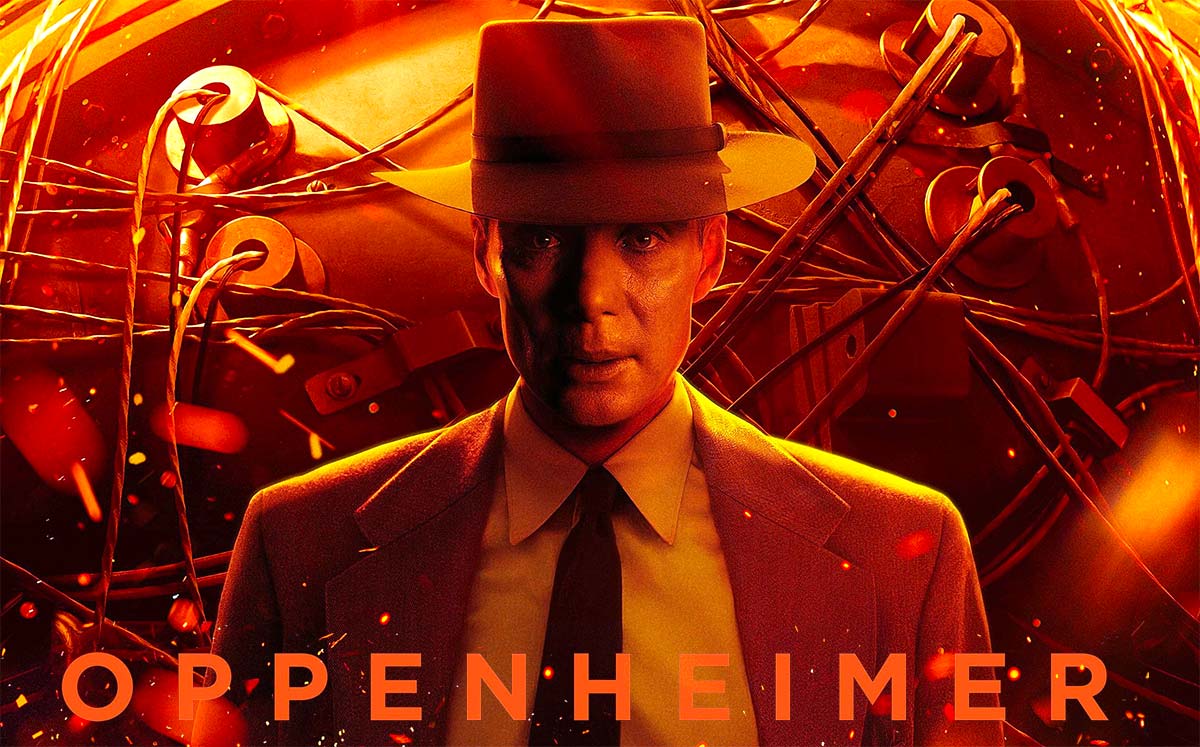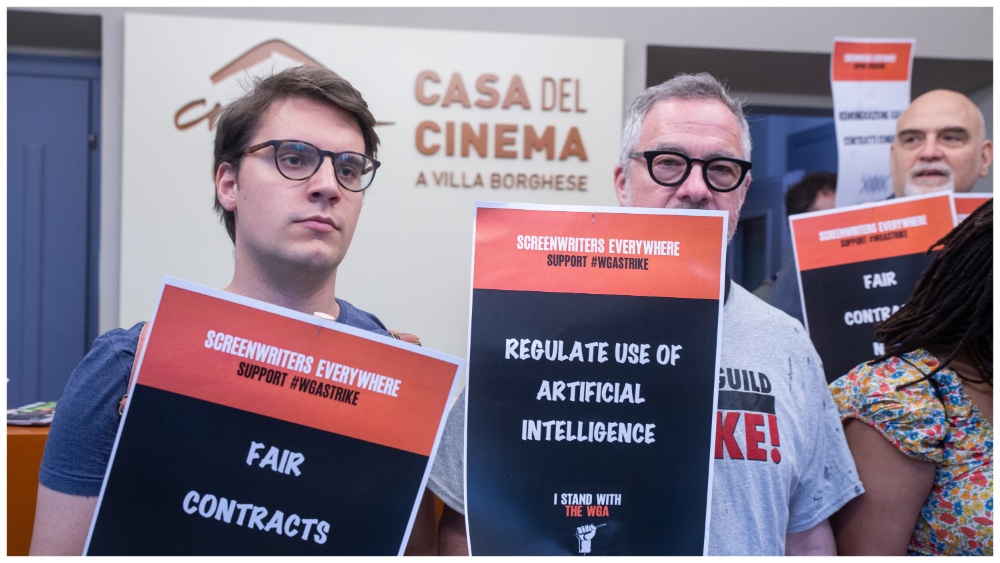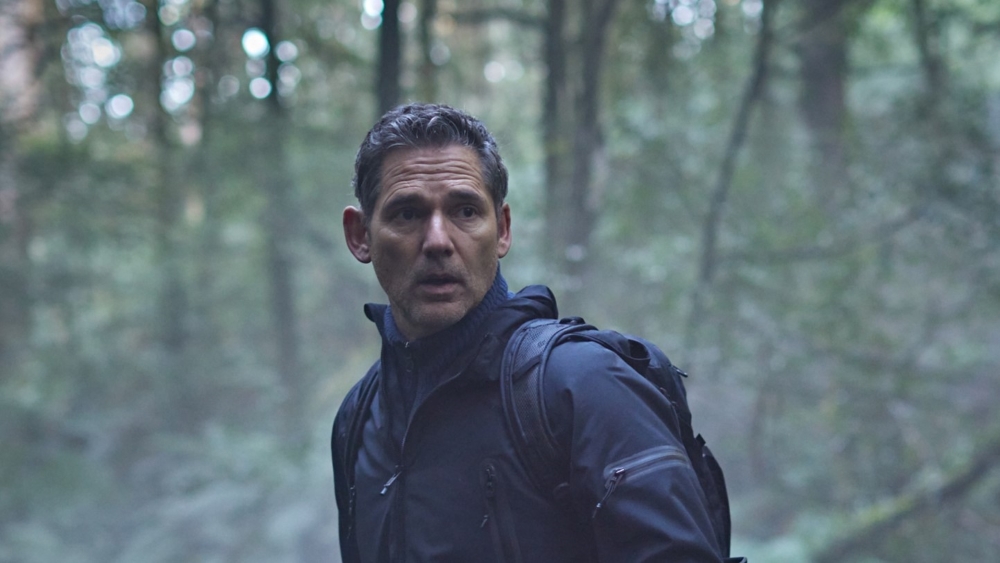
A film adapted from a book entitled “American Prometheus” was not going to be subtle about its inspirations. Christopher Nolan’s “Oppenheimer” offers nothing short of a mythological retelling of American history as modernism’s end. At its core is Cillian Murphy’s J. Robert Oppenheimer, rendered in all his complications as savior and sinner, redeemer and rebel. Just try and distill the detailed rendering of the famed theoretical physicist and creator of the atomic bomb into a neat fable. There’s just too much to compress in this huge and human epic.
The closest guide Nolan provides in “Oppenheimer” are two titles that appear over shots early in the film. The first, “Fission,” aligns most closely with Oppenheimer himself and the nuclear technology he pioneered. His atomic bomb harnesses energy by splitting the nucleus of an atom into two lighter ones. The second, “Fusion,” eventually reveals its association with Robert Downey Jr.’s Lewis Strauss, a government official with a zeal for developing the more destructive force of a hydrogen bomb. This nuclear fusion combines nuclei to create something heavier and larger.
Fission and fusion are thematic signposts mapping loosely to Terrence Malick’s ethereal “way of grace” and brutish “way of nature” from “The Tree of Life.” Nolan’s most impressionistic montage to date, crafted with agility and awe by editor Jennifer Lame, links Oppenheimer with a hidden universe of light and life. The physicist’s immense capacity for dense theory enables him to connect the dots between the arts and sciences of his era. This knowledge, combined with his left-wing political sympathies, leads him down a path of technological development he believes can paradoxically save humanity from war and conflict.
If ever there were a film about a Princeton academic deserving of the title “A Beautiful Mind,” it’s this one. But with that beauty, rendered in vivid albeit muted colors by DP Hoyte van Hoytema, comes a burden. Oppenheimer sees the world not as perfect but as perfectible. His higher calling, as well as his hubris, is to be the change agent who can both enlighten and lighten humanity. This turmoil plays out in the frequent close-ups of Murphy’s distressed face, a sight rendered overwhelming in the verticality of Nolan’s preferred IMAX 70MM exhibition format.
Feted like a deity but fated to be human, Oppenheimer’s innovation and idealism clash with Strauss’ ruthless realpolitik. This bloviating bureaucrat, stripped of Tony Stark-ian smugness in a brilliant performance by Downey, responds only to the nature of raw power and its ruthless exercise because he lacks a vision of his own. By constantly putting Oppenheimer on a pedestal and denigrating his own ilk as “mere mortals,” he pardons himself from the moral consideration behind developing bombs with genocidal capability. When Strauss wrests control of the narrative, Nolan shifts the color palette to a sterile black-and-white reflective of the simplistic binary through which he sees his own choices.
The interlocking structure of their thesis-antithesis dialectic gives “Oppenheimer” an odd but nonetheless steadily building momentum. Nolan kicks the habit of writing lengthy exposition and lets Strauss’ centrality to Oppenheimer’s story emerge organically. Over three hours, a dynamic develops recalling that of tragic hero Jean Valjean and his dogged pursuit by the legalistic Javert in “Les Misérables.” Each reveals the shortcomings and strengths of the other in their contrasts. Strauss only sees the figurative splash of the bomb, while Oppenheimer spots the ripples.
Strauss’ expectation that obedience to authority will bear its rewards casts Oppenheimer’s iconoclastic streak in stark relief. He’s willing to antagonize academic superiors (Josh Hartnett’s Ernest Lawrence), like-minded peers (Benny Safdie’s Edward Teller), and military oversight (Matt Damon’s Leslie Groves) alike with his insistence on running the Manhattan Project’s nuclear testing by his practical and political demands. He refuses to tame his libidinous urges, bedding a young communist psychologist (Florence Pugh’s Jean Tatlock) even while married to his iron-willed but sometimes tight-lipped spouse Kitty (Emily Blunt). He had no qualms romancing that wife, by the way, from right underneath a colleague.
Murphy embraces and embodies all these contradictions of his character, finding a compelling consistency amid the complexity. This works in large part because Oppenheimer knows his imperfections and harnesses them to achieve a layer of invincibility. He’s never short on words, especially to spin the messiness of his project into the promise of future magnificence. Yet as the realization of his design inches toward detonation, he’s rendered increasingly silent.
Oppenheimer is far too stoic a man to ever cry. But as he surveys the aptly named Trinity bomb’s fearsome cloud cloaking the New Mexico desert with light, his awe-struck reaction recalls the tears of two historical giants. Alexander the Great wept, for there were no worlds left to conquer, and Oppenheimer here realizes that he has reached the apex of his Promethean prowess. In the shortest verse of the Bible, Jesus wept – but from compassion for humanity’s well-being. Oppenheimer appreciates the martyred divinity’s concern anew when he realizes that, in bringing his inner visions to bear in reality, he’s handed civilization the tool to produce its own demise.
The restless, relentless motion toward the Manhattan Project’s culmination forms but a fraction of Nolan’s hefty story in “Oppenheimer.” The filmmaker’s curiosity to continue playing without action genre tropes sees him adopt something of a courtroom drama style. He’s pulling from Aaron Sorkin’s “The Social Network” script in his uncharacteristically rapid-fire dialogue, not to mention the narrative backbone of interrogating an influential inventor behind a misunderstood creation. Oppenheimer’s disregard for the rules won him praise to fight fascism in World War II, but that same spirit inspires panic when he uses it to question American power to fight communism during the Cold War.
From a visual standpoint, however, the tight framings of Murphy absorbing slanderous accusations for the very things that once won him success harkens back nearly a century to the expressiveness of Falconetti in the silent cinema classic “The Passion of Joan of Arc.” Nolan recognizes the value of sliding scales in his aesthetic. He locates the same impact in the agony of Oppenheimer’s torturous trial seen in close-up as he does in the ecstasy of quantum physics made real in sweeping landscape vistas. The sound design also finds as much to say with silence as it does with a big boom. Like his subject, Nolan tries to synthesize the extremes – and can similarly suffer from the occasional bout of shakiness in doing so.
Like “Inception” and “Tenet,” it’s easy to read “Oppenheimer” as a window into Nolan’s filmmaking. A (sometimes) misunderstood visionary has a big idea to execute, and he must assemble a wide array of talented craftspeople to bring the dream to fruition. Learning how to collaborate provides some of the most joyful moments in Nolan’s spry, surprisingly witty script. Oppenheimer’s interactions with Lieutenant General Leslie Groves, an entity akin to the producer or studio boss for the Manhattan Project enterprise, showcase how dissent and diversity of viewpoints can strengthen a collective effort. Damon excels when demonstrating his character’s brawny, bombastic military man slow adaptation to provide adequate support the brainy genius necessary to his mission.
Representations of directors in previous Nolan films form the basis for allegory. “Oppenheimer,” however, makes for something more like an apologia. This self-critical work feels like the filmmaker mounting a heavy-hearted defense of his own efforts. Murphy’s protagonist does not resemble a slick action hero surrogate like those played by Leonardo DiCaprio or John David Washington.
Rather, Oppenheimer looks much more like the egomaniacal, self-loathing avatar of Bob Fosse in his similarly reflexive film “All That Jazz.” Down the dissociative spells of stunned silence and collapsing boundaries between fantasy and reality, the character’s doomed quest for absolution through work reverberates all the more profoundly because it feels imbued with Nolan’s own personal reckoning. His willingness to represent that tussle both visually and thematically results in some of the most stunning and surprising moments in his filmography to date. Reality matters to Nolan, so it follows that the most combustible element of “Oppenheimer” is his witnessing his stand-in’s grip on it become tenuous.
“Oppenheimer” lands with nothing short of the mighty impact suggested by its legendary stature. But Nolan is less interested in reifying myths so much as he’s invested in rectifying them. His central character’s morass of abandoned principles and apocalyptic prophecies takes a sledgehammer to the “Great Man” biopic formula. The alternating narrative rhythm with Strauss encourages viewers to see the significance of Oppenheimer, “Amadeus”-like, through the eyes of those who fear nothing more than their own insignificance. Each informs the other here in rich, refined shadings.
But Nolan’s most powerful provocation in “Oppenheimer” lies in his suggestion that the American Prometheus came not only to deliver knowledge through science. His take on the myth reimagines the figure’s coming as also exposing destructive forces that already existed within the national character: self-satisfaction, jealousy, and insecurity. Oppenheimer’s worst fears come true after all. His bomb can ignite the atmosphere and trigger a devastating chain reaction. Just not the one he thought. [A-]
“Oppenheimer” will be released in theaters Friday, July 21.
‘Oppenheimer’ Review: Christopher Nolan Majestically Turns the Manhattan Project into American Myth







